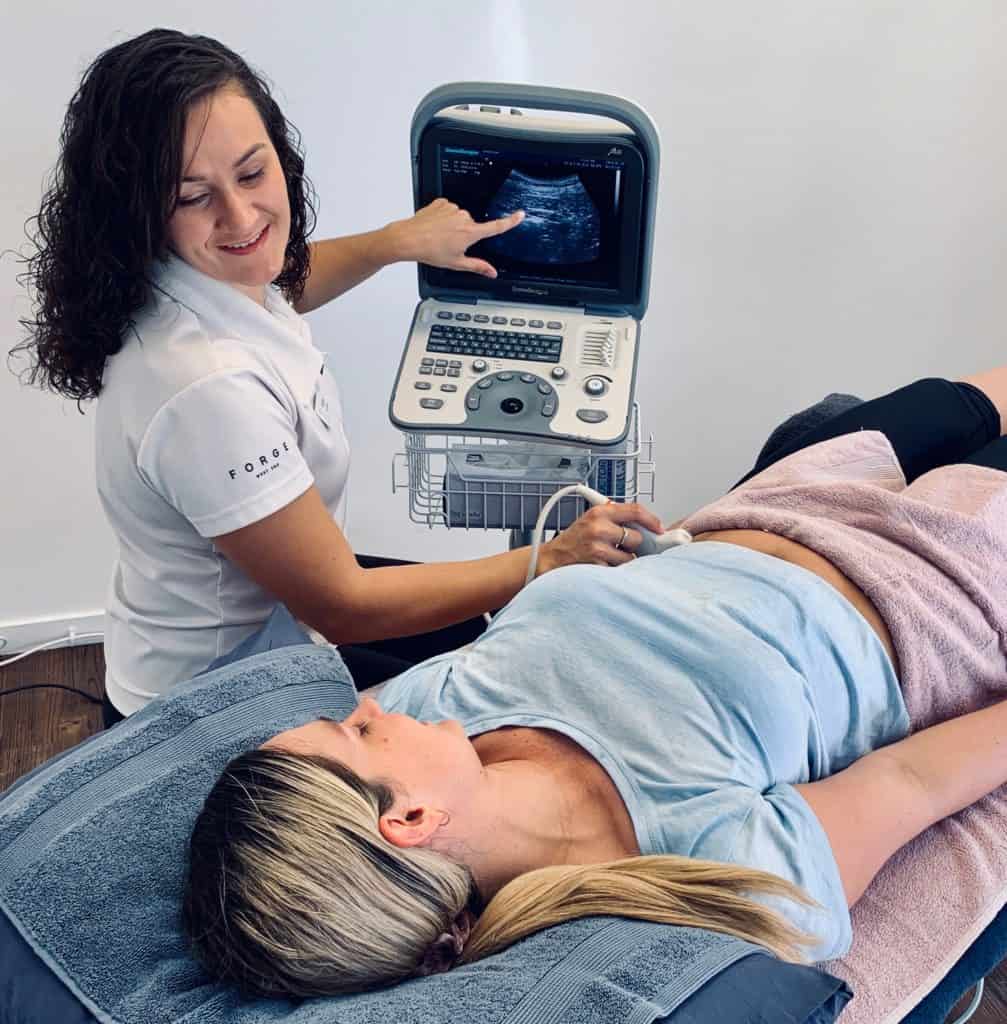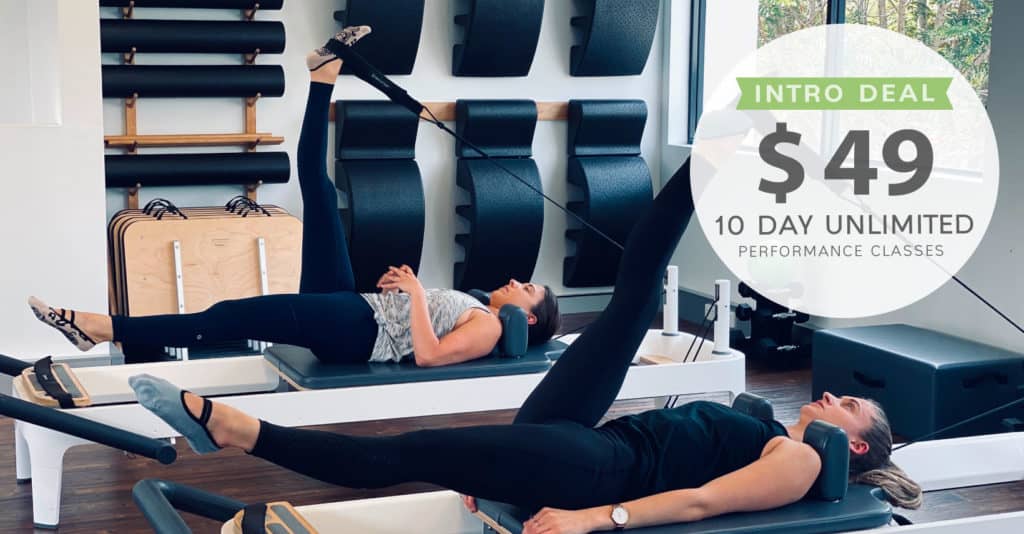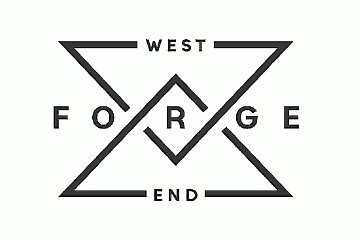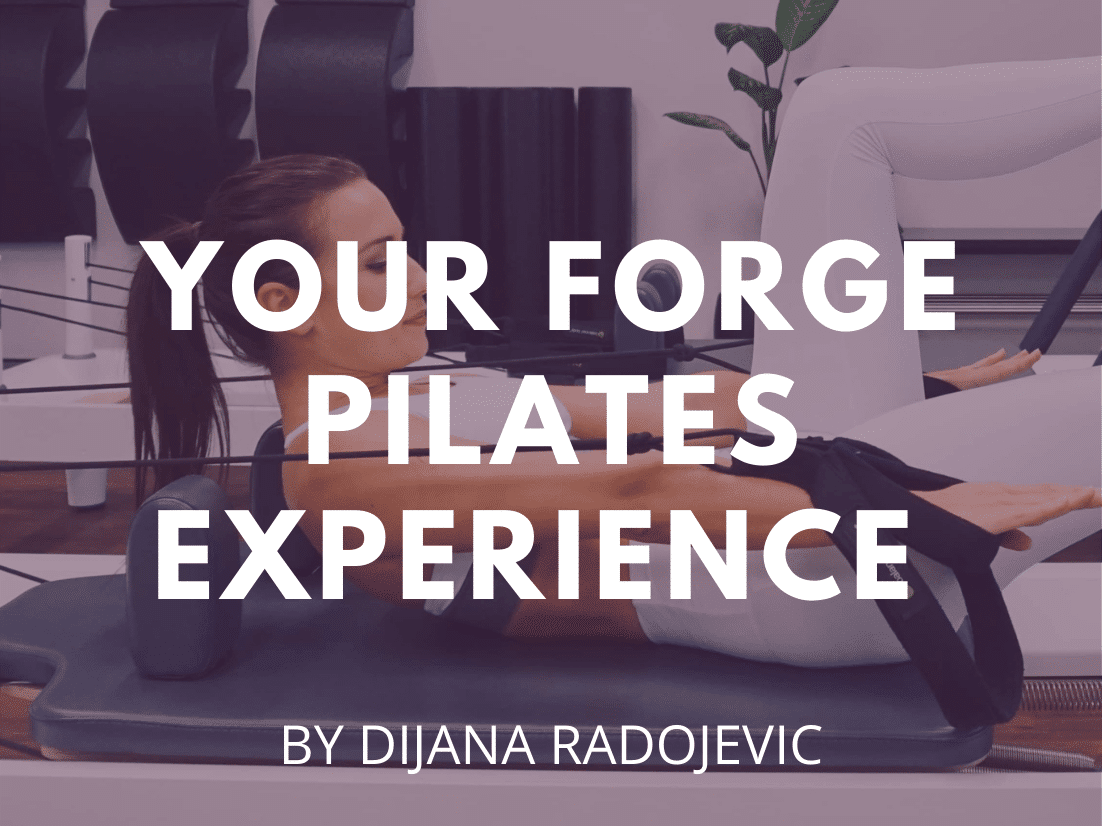YOUR FORGE PILATES EXPERIENCE
The first time you take any new fitness class can be a little intimidating. But for some reason, Pilates classes have an extra air of “avoid this if you don’t know what you’re doing or if you have an acute injury.” Maybe it’s the reformer, with its straps and springs, or that even scarier torture-looking machine – the Cadillac. Maybe it’s the exercise names that you’ve never heard before like the ‘Pilates Hundred’ or ‘Rolling like a ball’. Still, Pilates is frequently recommended as a way of helping you improve your posture, regain flexibility and improve strength following an injury, and often these days recommended by your Physio, GP or Sports Doctor.
Every body is different and Pilates is a movement modality that caters for this, with a wide variety of exercises and exercise modifications. Pilates improves muscle activation and functional movements as well as develops body awareness, strength and coordination. In addition to the health and fitness benefits, Pilates draws attention to body posture. Not just optimal postural alignment but also identifying postural faults that can be corrected with specific exercises.
If you’ve wanted to try Pilates but haven’t been sure where to start or if it is for you, read on to learn what your Pilates experience at Forge will look like.
1. There are so many types, which class should I choose?
At Forge, our Studio Pilates class is a fusion of traditional Pilates with the additional element of clinical rehabilitative knowledge delivered by our highly trained Pilates instructors. It is how Pilates was traditionally taught, prior to group reformer classes becoming incredibly popular. In a Studio Pilates class, you’ll workout on all the Pilates studio equipment (yes, there’s more than just the reformer in a Pilates studio!). This is a great class to try as your first one as it moves at a much slower pace and you get a lot more one on one time with your instructor.
If you like the idea of a more traditional class, moving at a tempo and in sync with others, our Beginner Reformer classes will facilitate this helping you focus on key Pilates Principles and slowly introducing you to all of the reformer exercises modified to your level and skill.
2. We keep our classes small
In order to attain maximum benefits from Pilates, the exercises need to be performed with accuracy and precision. Because of this, we keep our Pilates classes small, max 4 in our studio Pilates and max 6 in our reformer classes, to ensure you work with close eyes on form and technique.
3. So anyone can join but why should I consider an Initial Assessment?
During your Initial Assessment, our Physiotherapists will use a real-time Ultrasound to observe the activation and endurance of your Transverse Abdominus and Pelvic Floor Muscles (Deep Core Muscles) not visible through a standard visual assessment. The ultrasound probe will be gently moved across your abdomen to accurately observe the muscles activating. This process will allow you to correctly learn how to activate these muscles during your Pilates practice and any variations that would assist your specific needs. The initial assessment also allows us to complete a full Musculoskeletal and Functional movement assessment and recommendations can be made to which class would be best suited for you and your body especially if you have an injury or particular goals you want to work on.

4. 5 key Pilates Principles
You may have heard Pilates teachers talk a lot and are constantly repeating “draw your shoulders back, activate your T-zone, Elongate and lengthen in your spine”. So why are they so repetitive and focused. Any Pilates that incorporates modern theories of exercise science and stabilization and spinal rehabilitation should involve the following biomechanical principles.
- BREATHING: A three-dimensional breath pattern is encouraged, expanding the rib cage in all directions without neglecting anterior, lateral or posterior portions. This style of breathing brings about effective oxygenation of the blood, focuses the mind on each task and helps avoid unnecessary tension. A specific breathing technique also accompanies certain exercise motions so that the most effective core activation can be achieved and intra-abdominal pressure controlled.
- PELVIC PLACEMENT and CENTERING: Instructors will encourage a neutral spine position – often explained by allowing a small enough gap in your lower back area to fit a small blueberry. This is the most stable and effective shock-absorbing position and a good place from which to promote efficient movement patterns.
- SHOULDER BLADE PLACEMENT: Stabilising scapulae on the rib cage is as important as contracting the abdominal muscles during the initiation of every exercise. When stability is absent, there is a tendency to overwork muscles around the neck and shoulders.
- RIB CAGE PLACEMENT: The abdominal muscles must often be recruited to maintain the rib cage and the thoracic spine, in proper alignment. This is key in helping avoid build-up of tension in the back muscle.
- HEAD and CERVICAL ELONGATION: You will often be told to imagine a string pulling the top of your head, or gently holding a soft peach between your chin and neck. Correct Neck Posture is key in all Pilates exercises to help provide spinal stability by those deeper neck core muscles and also decrease tension in surrounding more superficial muscles.
By introducing these principles and reinforcing them with each exercise we can achieve optimal neuromuscular performance as well as developing core stability while safely balancing muscular strength with flexibility
5. You will feel your muscles burn during the session and most likely will feel sore the next day.
You may not be crushing high-intensity exercises like squat jumps or lifting heavy dumbbells, but the body weight exercises that the Pilates classes offer can be pretty intense especially when combined with the springs and equipment. Whilst you may begin the class focusing on activating the deeper core and finer muscle groups around the body you will eventually progress throughout the class to apply these key Pilates principles to more global and functional movements, giving you an overall body workout.
6. Wear formfitting clothes or comfortable sportswear — and don’t forget your socks!
For ladies, even if you typically prefer loose-fitting workout wear, you’re going to want to wear body-hugging options for Pilates classes. This way, the instructor can see your movements better to correct your form if needed and your clothes don’t stifle movement or caught in springs or other equipment. Gents should look to wear comfortable sportswear with shorts/pants that allow stretch. Socks are especially important – particularly those grippy ones (which we have available for sale, if required). Socks will help keep you grounded and safe throughout your workout.
7. Pilates completes a well-rounded fitness plan
Pilates stretches, strengthens and aligns your body, all at the same time. With that said, it also complements every other fitness endeavour because it prepares your body to move better, with greater control and efficiency. Adding it into your routine will help you run faster, lift heavier weights, cycle harder, swim with better form and even achieve those advanced yoga moves.
Beyond the general fitness and wellbeing benefits of Pilates, we particularly love using it in our Physiotherapy and Exercise Physiology sessions to achieve the best results with rehab and post-injury recovery.
8. Try it out and see if it’s for you!
One thing that can really help motivate you into starting something new is an easy 10 Day Intro Trial. Attend as many classes as you like in 10 days and see what all the Pilates hype is about. View schedules and book your classes using our ‘Forge Pilates’ App, with over 30 different Pilates classes and styles each week, it’s easy way to get started.

Comments are closed.

